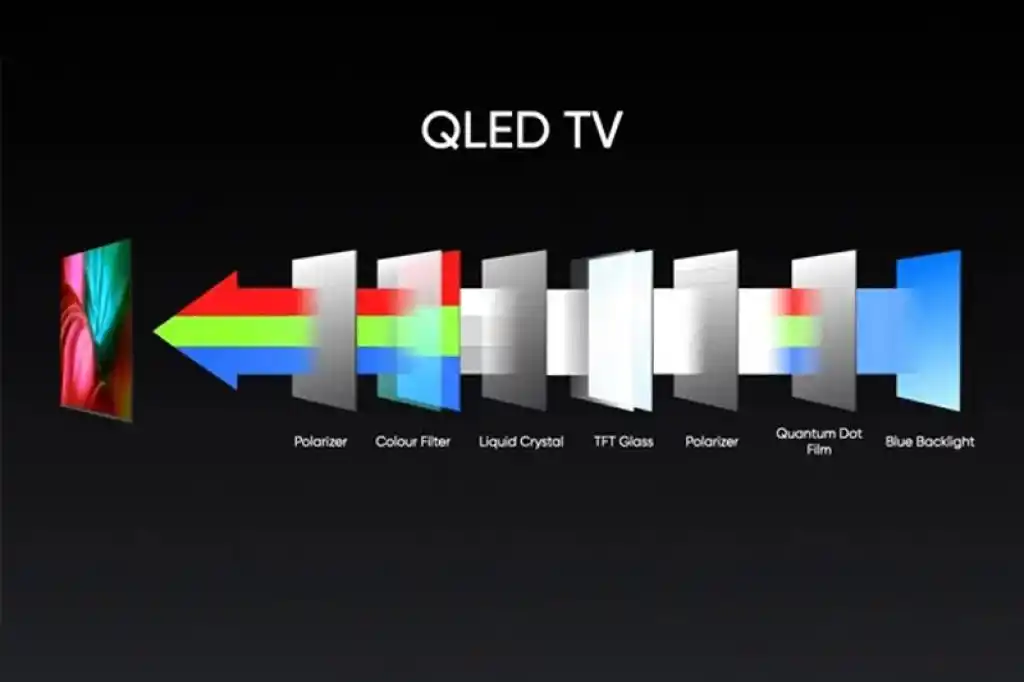QLED TV is a type of television that uses quantum dot technology to enhance the color and brightness of images compared to conventional LED TVs.
Quantum dots are very small semiconductor nanoparticles that emit a very specific color of light when illuminated.
But the most useful feature of this is that the manufacturer can precisely control the color of light by just changing the size of Quantum dots used in the panels!
This is considered one of the biggest advantages of QLED TV.
However, everything has its pros and cons and QLED is no expectation!
This article will walk you through everything you need to know about QLED Technology and the TVs made by it.
Let’s move on…
How QLED Technology Works?

In our previous article, we discussed how an OLED TV works.
However, the operation functionality of QLED is more complex than OLED and requires a deeper understanding of quantum dots and their interaction with light.
Here’s the breakdown:
- LED Backlight: The foundation of a QLED TV is an array of LEDs. This backlight produces a broad spectrum of white light, which passes through the following layers.
- Quantum Dot Enhancement Film (QDEF): This is the special sauce that defines QLED technology. The film contains billions of microscopic quantum dots made of semiconductor materials. These quantum dots possess a unique property:
- Size Determines Color: When illuminated by the backlight, quantum dots emit their own light. The color of the emitted light depends entirely on the size of the quantum dot. Smaller dots emit blue light, while larger dots emit red light. By carefully tuning the sizes, manufacturers can produce a highly controlled spectrum of red, green, and blue light – the building blocks of a display image.
- Color Filter: Once the quantum dots release their pure colored light, it passes through a color filter to fine-tune any variations in color before reaching the next stage.
- Liquid Crystal (LCD) Layer: This layer uses an electric current to manipulate liquid crystals, which form tiny shutters. These shutters open and close with great precision, creating variations in light intensity which form the pixel patterns we see as an image.
Those are the main parts, but there are also other layers at play, like polarizers and diffusers.
They help manage how light spreads out for better viewing.
That’s it…
All these parts work together to make the beautiful display you see. By using quantum dots along with LCD technology and some other layers, QLED TVs can show colors accurately and make bright, clear pictures.
| Pros | Cons |
|---|---|
| Excellent brightness and vivid colors, suitable for well-lit rooms | Reliance on a backlight unit, leading to issues such as light bleed and limited viewing angles |
| Immunity to burn-in, a common issue with OLED TVs | Less saturated blue and lower contrast ratios compared to OLED TVs |
| Lower cost compared to OLED due to the absence of an expensive vacuum evaporation process | Higher power consumption compared to OLED TVs |
| Availability in larger display sizes, providing more options for consumers | Concerns about lifespan and potential future technology developments |
| Thin and lightweight design | |
| Faster switching speed and lower power consumption compared to CRT and LCD displays |
What about Lifespan?
Samsung, the pioneer of QLED TV, stated in documentation on their website that QLED TVs can last anywhere from 7 to 10 years with heavy use.
This is slightly longer than the average lifespan of LED TVs, which is around 4.5 to 7 years.
Of course, the actual lifespan will depend on various factors such as your usage habits, screen brightness, and the quality of the TV’s components.
I checked a bunch of discussions on Reddit, and most of them reported no issues, no burn-in, and no brightness reduction after several years of use. However, some users also encountered problems such as vertical lines, banding, or burn-in after heavy or extreme usage.
So, it depends on your luck and your usage pattern!
But QLED is definitely a better option if you have the budget to invest and want a high-quality, long-lasting, and vibrant display for your home entertainment
F.A.Q.s
Q: How does a QLED TV compare to an OLED TV?
QLED TVs and OLED TVs are both high-end options, but they use different technologies.
QLED TVs are generally brighter and have better color accuracy, while OLED TVs have better contrast and deeper blacks. It ultimately comes down to personal preference and the specific features you prioritize.
Q: Are QLED TVs energy-efficient?
QLED TVs are generally more energy-efficient than traditional LED TVs, but they may not be as energy-efficient as OLED TVs.
The energy efficiency can vary depending on the specific model and features of the TV.

Abdul Kader, a handy guy and experienced founder of a TV repair shop in Gulshan, Dhaka, Bangladesh. He is mainly an expert in understanding and repairing different types of issues with Smart TVs and providing helpful insights on how to keep them in good working order. Read his Full Story.

